Contrast increasing using USM







Alright, so it's not time-travel. All time-lapse photography is, really, is shooting a bunch of photos of the same thing, spread out over a period of time, and smushing them together into one video that plays back in a shorter amount of time. In the words of our pal Genie, "Phenomenal cosmic powers… Itty-bitty living space!" Yeah, time-lapse is kinda like that.
Time-lapse lets you see the natural progression of time, while not having to wait through the actual length of it… so you could watch the sunset (at least, yesterday's sunset) as you always wanted to, without staying up late to do so – and you could fit it all within a nice, brief commercial break in-between episodes of "Dr. Who" too.
Now, there's a few basic steps to take in creating a time-lapse film:
We know that you're a very clever sod and probably have some brilliant ideas already in mind for what to shoot in time-lapse form. But just in case, here are a few suggestions to get you thinking:
Ask yourself how much time you have to commit – the four hours it takes for a snail to get across the back porch might be a lot more do-able than the four months it takes a construction site to be finished.
Based on what you're shooting, you'll want to know how long your actual event or subject will last (or at least, how long you're willing to shoot for), whether you want your final movie to be blocky or smooth, how long you want your final movie to be, and based on all of that, how often (at what interval) you'll want to take photos of the event.
The Length of the Event
Usually the length of the project changes how you're going to shoot it. For longer-term projects, like this nifty time-lapse that documented a soon-to-be-mom's growing tummy throughout the nine months of her pregnancy, you might only need to get a new shot every day or so – you could do that with a point-and-shoot, and not need any fancy automated equipment.
Ask yourself how long you can go between photos while still documenting the action of the event; for change that is pretty big and radical over a shorter amount of time, you'll want to shoot it more often. For change that is gradual and slow over a longer time, you can have more lengthy intervals between shots.
How the Final Movie Appears
Your final movie can end up two ways: blocky or smooth and seamless. With blocky, shots will seem to abruptly change into the next – in a crowded street scene, for example, a person might appear in one part of the screen and then, blip!, suddenly be halfway across the screen in the next frame.
The alternative is blending the interval shots together, so that it appears smooth and seamless. Usually you do this two ways: drag your shutter speed when you're shooting, and shoot your subject more often (at shorter intervals).
Which is better? It's up to you! For events or time-lapse subjects where the change is gradual and slow (like a construction site), blocky might be fine. Where change occurs much faster (like a blossoming plant), smooth and seamless would probably be better.
The Magic Formula
Most movies show around 20-30 frames per second; the more frames per second, generally the smoother the movie will play back (though of course, this depends on other things too). If we're going to make E.T.'s flower come back to life, we'll want it to be shown at around 24 fps and be smooth and seamless.
We also need to ask how long we want the final movie to be. We're thinking E.T.'s flower coming back to life to should last around 30 seconds… so, some quick math to find out how many frames we need to capture:
Awesome. Now to find out how often (at what interval) we need to shoot frames of a flower decaying (we'll play the final movie in reverse to make it look like it's coming back alive). First we estimate how long the actual event lasts – about 4 hours (or 14,400 seconds), we think. Some more quick math:
So we have our plan, Stan! When you start your time-lapse project, we'd really recommend thinking ahead like this.
It really doesn't matter what you shoot your time-lapse photos with, as long as you shoot them – we've seen people use SLRs, point-and-shoot cameras, and webcams.
Whatever you use, we recommend you mount your camera on a tripod (unless you have Super-Man endurance and don't mind standing there holding it for eight hours or however long). If you don't have a tripod, wedge your camera between a couple books, or make a custom base for it.
Shooting with an SLR: Intervalometers If you have an SLR, we've got one bit of advice for you: get yourself an intervalometer. They're often called timer remote controllers, and they run about $60 – here's a good Canon one, and here's a Nikon one.
If you have an SLR, we've got one bit of advice for you: get yourself an intervalometer. They're often called timer remote controllers, and they run about $60 – here's a good Canon one, and here's a Nikon one.
With an intervalometer (or timer remote controller), you can program your camera to shoot at certain times and at certain intervals – such as 1 frame every 5 seconds, 1 frame every minute, and so on. This leaves you free to go do something else, when you're ready.
Now set up the rest of your camera:
The idea is that your camera's settings should change as little as possible while it's doing its thing.
Now, remember back when you decided between Blocky or Smooth? If you're after the smooth and seamless look in your final movie, you'll want to adjust your exposure (how long the shutter stays open to capture light while taking a photo) to be as long as possible. When you force your shutter to stay open a longer time (often called "dragging your shutter"), moving objects, like cars and people, will then appear more as a blur, and will "smear" across your scene. Your final move will have much smoother action this way.
The side-effect of long exposures is a lot more light coming at your camera – often too much light. If you're going to drag your shutter, we'd suggest getting a neutral density filter to help wrangle the extra light under control.
If you're going the SLR route, we'd also suggest taking a look at Zach Wise's awesome video tutorial on shooting time-lapse with an SLR. It's a great primer to begin with.
Shooting with a Point-and-Shoot: Time-Settings Some point-and-shoot cameras have an interval setting buried deep in their menu somewhere, but most don't – which means that, unless you want to sit there holding your camera however long and manually take the pictures, point-and-shoot cameras might not be your best bet.
Some point-and-shoot cameras have an interval setting buried deep in their menu somewhere, but most don't – which means that, unless you want to sit there holding your camera however long and manually take the pictures, point-and-shoot cameras might not be your best bet.
For some time-lapse ideas, that might work just fine – especially time-lapse videos where you only need one or two shots a day. A time-lapse of a baby growing in mom's tummy over the course of nine months, for example, would be great to shoot manually with a point-and-shoot.
There are also some extra add-on timer devices, like the Pclix, that will cause your camera to trigger at specified intervals – but they don't work with all point-and-shooters, so the chances might be slim of getting one that works for you. You could also hack your camera and wire it up to a home-made intervalometer… but, uh, do that at your own risk. And probably not with a brand-new camera.
Shooting with a Web-Cam: Time-lapse Software Amazingly, using a web-camera with your computer might just be the easiest route to take – thanks to some very nifty software.
Amazingly, using a web-camera with your computer might just be the easiest route to take – thanks to some very nifty software.
For Mac, there's the unbelievably cool freeware program Gawker. It immediately recognizes any iSight or web-cam hooked up to your computer – or even better, on any computer on your network – and after specifying an interval for it to take new shots at, gives you one-button time-lapse recording from that iSight. Even better, you can also combine views from multiple iSights or web-cams into a single, split-screen time-lapse video – or you could even use your computer desktop and what you're doing on it as a source for your time-lapse.
For PCs, Webcam Timershot – part of Microsoft's PowerToys package of free add-on software – does much the same as Gawker (minus the split-screen ability and having the option to record your desktop): specify an interval, and Webcam Timershot will take pictures from your web-cam and save them to a location you choose.
Last Minute Checklist
Ready too go? Good. But wait, a few last minute things:
 Whew. After all of that, can you believe you've finally reached the easy steps? All that's left is to download the photos to your computer, edit them if you want, and, with some software, assemble them into a movie.
Whew. After all of that, can you believe you've finally reached the easy steps? All that's left is to download the photos to your computer, edit them if you want, and, with some software, assemble them into a movie.
It isn't necessary every time, but sometimes you'll have a batch of photos that need just a little tweaking before anything else. Maybe the exposure or levels could use some nudging, or you want to adjust the saturation a bit. Great. One quick tip: Automate Everything.
In Photoshop, practice on one photo from the bunch, adjusting it to how you like it – then create an Action in Photoshop to do exactly what you just did. Close your photo without saving, then use Photoshop's Automate Batch command. Select the folder of all your photos – your source – and create a new folder for where the edited photos are gonna go – the destination. Then select your newly created Action, and Ok – off they go.
You'll end up with your batch of photos, all edited, in your new folder… lookin' good and primed to be put together!
Use Quicktime Pro to Assemble Your Photos Into a Movie After you've downloaded your photos to your computer and saved them in a folder somewhere, we've found the quickest and easiest way to assemble them into a final time-lapse video is to use Apple's QuickTime Pro (available for $30 at Apple.com for Mac or Windows).
After you've downloaded your photos to your computer and saved them in a folder somewhere, we've found the quickest and easiest way to assemble them into a final time-lapse video is to use Apple's QuickTime Pro (available for $30 at Apple.com for Mac or Windows).
Underneath the File window of Quicktime, select "Open Image Sequence", then navigate to the folder with your photos and select the first one. Hit okay, and then QuickTime will ask you how many frames-per-second you want your movie to have. QuickTime will do all the rest for you.
From here, you can export it for the web or save it so that you can add titles, music, and other effects to it in a movie editing program.
Or: Assemble Your Movie with iMovie or Another Application We found Quicktime Pro to be the best and easiest for this, but you can also accomplish pretty much the same thing in other video editing programs. To use iMovie, for instance, import all your photos into iPhoto. Once you have a new project started in iMovie, find your photos in the Media window, select them all (either by clicking and dragging your mouse or selecting the first photo and holding shift as you then select the last one too – all the ones in between should also be selected), and then open the Photo Settings for them. Set the duration for each photo to a nice small number, like "0:03″ – this will play each photo for 3 frames, adjust to your liking – and hit Apply to be done!
We found Quicktime Pro to be the best and easiest for this, but you can also accomplish pretty much the same thing in other video editing programs. To use iMovie, for instance, import all your photos into iPhoto. Once you have a new project started in iMovie, find your photos in the Media window, select them all (either by clicking and dragging your mouse or selecting the first photo and holding shift as you then select the last one too – all the ones in between should also be selected), and then open the Photo Settings for them. Set the duration for each photo to a nice small number, like "0:03″ – this will play each photo for 3 frames, adjust to your liking – and hit Apply to be done!
The photos will be added to your movie's timeline and you'll have the beginnings of a swanky time-lapse video.
(If you're using another application besides iMovie or Quicktime Pro, the process will likely be about the same – either opening an image sequence, or manually adding your photos in order and adjusting their duration.)
 After you have a time-lapse movie file, import it into iMovie or Final Cut Pro if you're a Mac fan, or Windows Movie Maker or Adobe Premiere if you're running Windows.
After you have a time-lapse movie file, import it into iMovie or Final Cut Pro if you're a Mac fan, or Windows Movie Maker or Adobe Premiere if you're running Windows.
Add some music and titles, and you're ready to show off your final movie!
You might also want to try some effects, like panning and zooming over your finished time-lapse movie, to add motion and hone in on what's interesting.






































To make a long story short: The "Polar Panorama Effect" is one of my favourite ways to process photos into unique pieces of art. It takes a panoramic (or at least a landscape-ish) photo and uses the Polar Coordinates filter of Photoshop or The Gimp to create a circular image that seems to wrap the panorama around a planet.
Here are two samples for you to get an idea:
In this article I will share my experiences with this technique, scribble together some things I found out and I will add a couple of links to help you get more out of it.
When selecting a photo to start with you should keep the following things in mind:
We have the easiest start when we start with a 360° panorama, so let's take my Panorama shot of San Francisco taken from the Coit Tower:
Use the Photo|Image Size menu item to change the image size into a large square. Uncheck 'Constrain Proporties' and set the "height" value to the same value as your "width" value. You will get a square image:

Now rotate the photo by 180 degrees…

… and apply the "Filter|Distort|Polar Coordinates" filter (choose the "Rectangular to Polar" setting). If you are a user of The Gimp the command is "Filters->Distorts->Polar Coords".

Well, as you can see that was already most of the magic:

The rest is just a little digital darkroom work: Rotate the planet to your liking, filter contrast and colors, clean up the sky and the edges where left and right border of the image came together.
Most of my planets were created using panoramas, but for this second sample we will use the following photo from Venice which shows San Girgio Maggiore Island. Islands are especially good suited for planets because on the left and right edge you only have the horizon to stitch together. This photo fits all the aspects mentioned above.

First we have to crop the image as needed and straighten it to make the horizon absolutely horizontal. Using the cropping tool of PhotoShop we can do both processes in one step:
First we must make sure that our crop window is parallel to the horizon. This image shows how you can do this:

Choose the crop tool of PhotoShop and select a flat rectangular area of the photo. Move the cursor just outside of an edge of the marked area where the cursor changes into two arrows pointing left and up. Click the mouse button and you can rotate the cropped area.
By moving the top border to the horizon of the photo you can exactly inspect the rotation. Move and rotate the crop window until the top border and your horizon is parallel, but don't activate the crop yet. Good. Now we have a selection that is horizontal.
Now we want to make sure the left and the right border of the image fit together. Using the same trick we now look for areas on the right and the left where the buildings have the same height:

Move the right and left borders as desired. Then finally move the top and bottom border in order to have the waterline roughly in the middle of the cropped photo:

Double click the image and you are ready for the transformation!

From here everything works like in the simple sample: Use the Photo|Image Size menu item to change the image size into a large square. Uncheck 'Constrain Proporties' and set the "height" value to the same value as your "width" value.

Now rotate the photo by 180 degrees and apply the "Filter|Distort|Polar Coordinates" filter (choose the "Rectangular to Polar" setting). If you are a user of The Gimp the command is "Filters->Distorts->Polar Coords".

Again, the rest is just a little digital darkroom work. Here are the things I did with this image:
The final result could then look like this:
| Source Panorama | Polar Panorama |
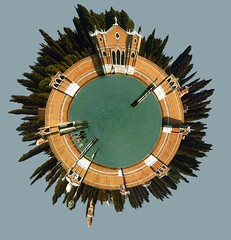 | |
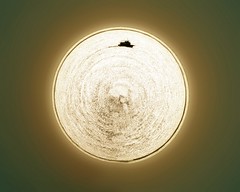 |  |
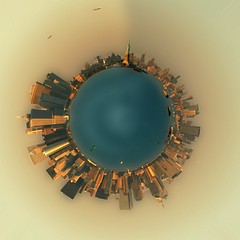 |  |
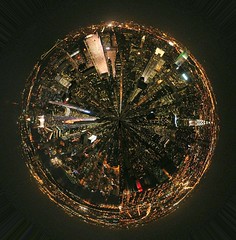 | |
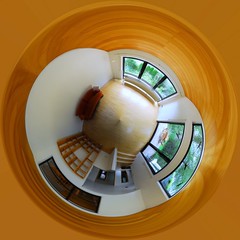 | 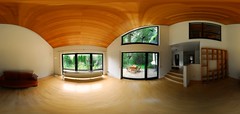 |
More on my Make Your Own Planets photo set on flickr.
Want to do more with this technique? Here are some suggestions:
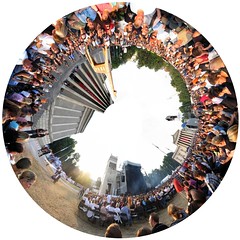
To create my panoramas I usually take the photos without a tripod and use AutoStitch (freeware) and PanoramaFactory (shareware $30) for the digital work.
The Flexify filter module ($35) for Adobe PhotoShop creates polar panoramas on-the-fly and offers numerous projections for your photos.
Dirk Paessler is 37 and is hooked on photography since 20 years. Have a look at his photoblog. When he is not taking photos he works as the CEO of Paessler, a software company creating network monitoring software.